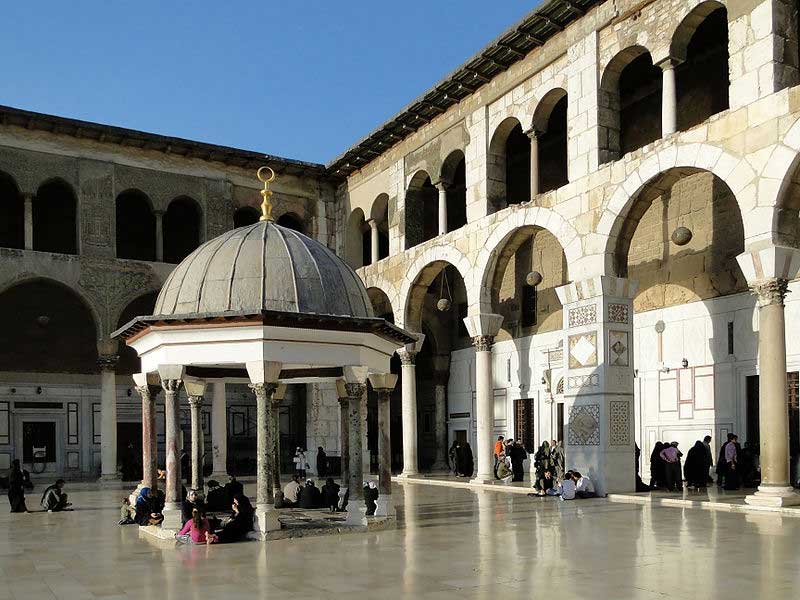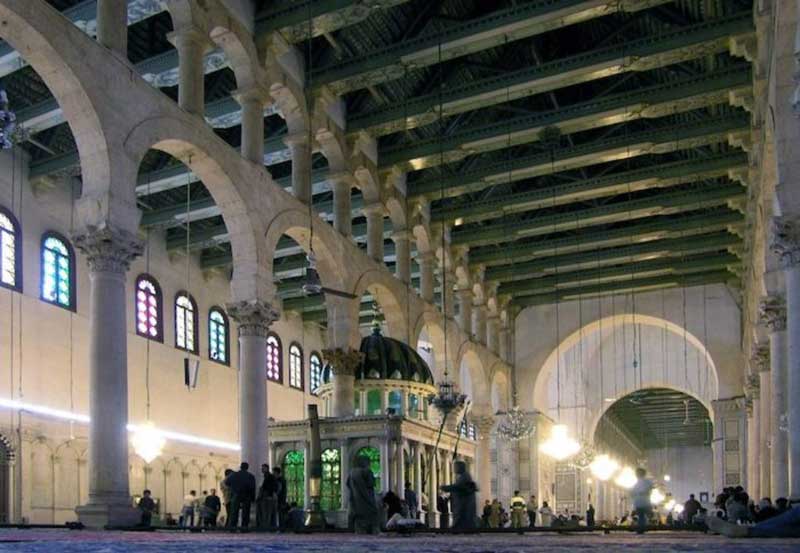
Located in the old city of Damascus and built between 705 and 715 AD by the Umayyad Caliph al-Walid I, Umayyad Mosque, also known as the Great Mosque of Damascus, is one of the oldest and largest mosques in the world and is considered the first monumental work of architecture in Islamic history. However, before the construction of the Umayyad Mosque, the site of the mosque housed sacred buildings for worship for thousands of years, which transferred forms to accommodate the faith of the time.
From the late 12th century BC to 732 BC, Damascus was the capital of the Aramaean state named Aram-Damascus and an Aramaic temple dedicated to Hadad-Ramman, the Semitic god of thunderstorms and rain, occupied the space of the present Umayyad Mosque. Only a single stone, remains of the ancient temple, was discovered later, and is now displayed in the National Museum of Damascus. Later, until 63 BC, Damascus was under the political control and cultural influence of the Greek dynasties when the temple of Hadad-Ramman was converted into a temple of Zeus-Hadad as he was the king of the Greek gods, associated with thunderbolts.
After that, when the Romans conquered Damascus in 64 BC, they assimilated Hadad with their own god of thunder, Jupiter, and built a Hellenistic temple, dedicated to the Roman god Jupiter that served as a response to the second temple in Jerusalem. For several centuries the great temple of Jupiter marked the spiritual heart of the city. However, once Christianity was widely adopted in the eastern part of the Roman Empire, the temple of Jupiter was converted into a cathedral by the Christian emperor Theodosius in 391 AD, which was dedicated to John the Baptist. It is said that the head of St John was buried there, who was beheaded on the orders of Herod Antipas, a local ruler sometime before Jesus' crucifixion.

The political situation of Damascus changed when it was captured by Muslim forces in 634 AD, under the leadership of Khalid ibn al-Walid. Although the Muslims agreed to respect the lives, property, and churches of the Christians, and the Christians retained control of their cathedral, the Muslim worshippers reportedly used to pray in a hall placed against its southern wall. In 661, when the Islamic State of caliphate came under the rule of the Umayyad dynasty, Damascus became its capital, and Caliph al-Walid, the sixth Umayyad caliph, commissioned the construction of a big mosque in 706 AD on the site of the Christian cathedral to provide space for prayer, sufficient to accommodate the growing population of the Muslims.
He also intended to make it a congregational mosque, the most important mosque in the city and its neighbourhood, where the community of believers would gather to pray and hear a sermon on Fridays. To take over the site, the caliph negotiated with the Christian leaders, and in return, promised safety to all the churches around the city, along with the construction of a new church. Unfortunately, Caliph al-Walid did not live to see the completion of the huge Umayyad Mosque, which was completed by his successor, Sulayman ibn Abd al-Malik in 715.

The rectangular Umayyad Mosque, measuring 318 feet (97 m) by 512 feet (156 m), contains a large open courtyard, enclosed by four exterior walls surrounded by an arcade of arches supported by alternating slender columns and piers. The exterior walls that surround the courtyard have three gates connecting the city from the north, the east, and the west side. As it is believed that the haram, one of the five Islamic commandments that define the morality of human action, occupies the south, it has a door that links directly to the outside of the mosque complex. The courtyard contains the ablution fountain for washing before prayer, covered with a dome supported by columns, the Khazne Dome, or the dome of the elevated treasury on the western side supported by eight Corinthian columns, and the Zein al-Abdin Dome, or the Dome of the clock on the eastern side, also supported by eight columns. The courtyard leads to the prayer hall resembling the Christian basilicas, without apse, toward which one would pray. The three riwaqs or the arcades intersected in the middle with a larger and higher arch, perpendicular to the Qibla wall, the direction of prayer. It has a niche called a mihrab, indicating the direction of Mecca towards which the congregation faces to pray. Out of the four mihrabs, the main one, known as the Great Mihrab, is located at the centre of the rear wall of the sanctuary, while the Mihrab of the companions of the Prophet is in the eastern wall.

Out of the three known domes inside the complex of the Umayyad Mosque, the main octagonal dome, known as the Nisar Dome, or the Dome of the Eagle, is the largest. Following a fire in 1893, the original wooden dome that was thought to resemble an eagle was replaced by a stone-built one. With a height of 118 feet (36 m), the dome is supported by the central interior arcade and rests on an octagonal substructure with two arched windows on each of its sides.
Among the three minarets within the complex of the Umayyad Mosque, the Minaret of the Bride located on the northern wall of the mosque is the oldest. The minaret, equipped with a spiral staircase containing 160 stone steps leading to the top, was used by the muezzin for the call to prayer. Although the exact year of its construction is unknown, its lower part possibly dates back to the 9th century. However, there is no doubt that the upper segment of the minaret was constructed in 1174. The square-shaped minaret with four galleries has two light openings near the top. It is said that the minaret is named after a young woman, married to the then ruler of Syria, whose merchant father provided the lead for the roof of the minaret.

With a height of around 253 feet (77 m), the Minaret of Jesus or the Minaret of Isa, located on the southeast corner of the complex, is the tallest of the three minarets. While its main body was built by the Ayyubids in 1247, the upper section was constructed by the Ottomans. Its square-shaped main body is topped by an octagonal spire that tapers to a point and is crowned by a crescent, like the other two minarets. It has two covered galleries in the main body and two open galleries on the spire. According to Islamic belief, Jesus would descend from heaven before the Day of Judgement to reach the earth via this minaret, to confront the Antichrist.

Built by Mamluk sultan Qaitbay in 1488, the western minaret of the Umayyad Mosque complex is known as the Minaret of Qaitbay. Displaying strong Islamic-era Egyptian architectural influence, the minaret is octagonal in shape and built-in receding sections with three galleries. It is mostly believed that both the Minaret of Qaitbay and the Minaret of Jesus were built on the foundations of Ancient Roman towers. But some scholars argued about the feasibility of the claim because of the absence of corner towers in other former Roman temples.
The Umayyad Mosque is one of the rare examples of the few early mosques in the world to retain its original look. Since its initial construction in the early 8th century, it has not changed significantly and maintained the same general structure and architectural features. After Damascus was besieged by Timur in 1400, he ordered to burn the city to ashes on 17 March 1401. The consequent fire ravaged the Umayyad Mosque when its eastern minaret was reduced to rubble and the central dome collapsed. Later, the burnt mosque was restored, and despite it lost its original grandeur, the restored Umayyad Mosque is still an impressive architectural monument.

The Umayyad Mosque has great significance to both the Shia and Sunni Muslims because it was the place where the family of Muhammad was imprisoned for 60 days following the Battle of Karbala.